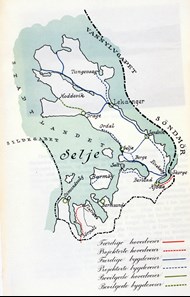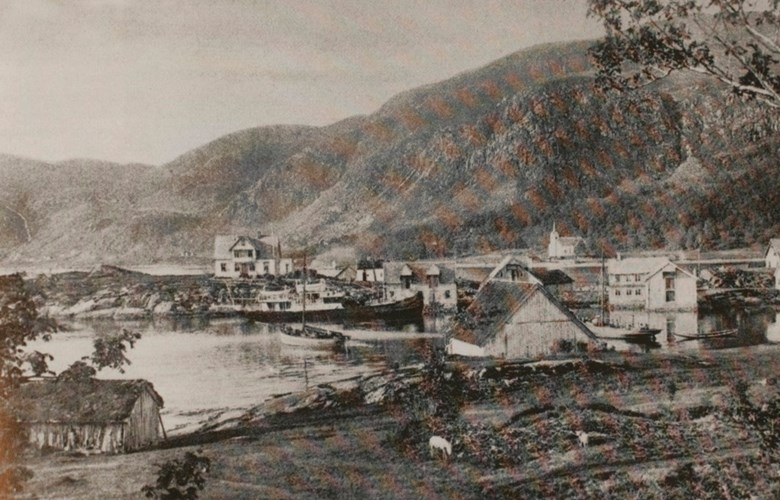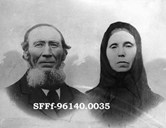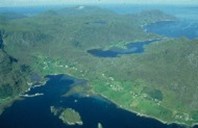The municipality of Selje in 1905
In 1900, the Selje municipality had 5467 inhabitants and the parish consisted of the main sub-parish (¿sokn") of Hove with Leikanger chapel and the Vågsøy ¿sokn". In the autumn of 1906, the issue was raised whether Vågsøy should be separated from Selje. As of 1 January, 1910, the two church ¿sokns" of Nord-Vågsøy and Sør-Vågsøy were established as municipalities in their own right. In the same year Hove ¿sokn" changed its name to Selje ¿sokn". At a municipal border regulation in 1964, the island of Silda and the farms of Sørpollen and Straumen were transferred to the municipality of Vågsøy. In 2001, with the present borders, the population in the municipality of Selje was 3023. With the same geographical area, the population in 1900 would have been 2783. Selje has thus had a low population growth in the past century. In 1918, the municipality had the following school districts: Selje, Leikanger, Refsnes, Kjøde, Stokkevåg, Borgundvåg, Eltvik, Honningsvåg, Hoddevik, Drage, Moldestad, Sandvik, Nordpollen, Barmen, Flatrake, Årvik, Fure, Eide, Røyset, Silda, Sørpollen, Osmundvåg and Hagevik. The longest distance to school was still six-seven kilometres in spite of such a decentralized school structure.
Communication in 1905
In 1904, the local steamship company ¿Fylkesbaatane" had three stops in Selje: Barmen (365 passengers), Drage (774 passengers) and Selje (1516 passengers.) The village of Drage was extremely exposed to the weather and in 1893, a 72-metre-long jetty was completed. After this, the steamships called at Drage, ¿weather permitting". The jetty at Drage was discussed many times in the local council in 1905. The council appointed a person to look after the jetty and the crane at Drage, and on one occasion they discussed a letter from Gullak J. Drage concerning a conflict as to the cession of property for the jetty. In 1905, Peder P. Drage applied to the municipal council to be paid for the use of telephone at Drage. Among other issues discussed by the local council in 1905 was an application from the church supervisory board of Selje to put up notices against spitting on the church floor. All these matters give us some idea of local issues in the first decade of the 20th century.
The roads in Selje
About 1900, roads were built in many places in Selje. From the village of Indre Drage there was a road across Dragseidet to Leikanger chapel. The road continued to Mork, down the valley of Morkadalen by way of Dalsbø and Ferstad, ending at Ervik. The total length of this road was 18 kilometres and it was the longest continuous road in the municipality. There was also a road from Ferstad across to Årvik, and from Leikanger chapel to the Sandvik farm. At this time they were also working on the road from Sandvik to Selje. From Einehaugen by the bay of Kjødepollen there was a road across Mannseidet to Selje. From Eide there was also a road to Berge.
There were posting stations at Osmundvåg, Drage and Leikanger. There were also some riding paths and tracks in the municipality. There was a riding path from Eide along the coast to Berstad, and from Berge to the Selje church. Another path went from the Selje church across Sandvikseidet to Sandvik, and from the Selje church across Pileberg and on the western side of the lake of Fløytevatn to the Leikanger chapel.
The municipal council discussed many cases that had to do with building roads. A case in point from 1905 was an application from Nikolai Eltvik concerning siting and cost estimate of road from Leikanger to Eltvik.

Bank and post
Selje Sparebank (savings bank) was established in 1893, with total assets in 1899 amounting to 237.967 kroner. Converted to 2004 kroner this comes to about 14 million. In the local paper "Fjordenes Blad" of 15 March it was written: "Financed by the bank¿s own means, a modern bank building will be built near the vicarage or at Hamre, as the bank now owns a substantial primary capital and reserve fund and the extent of our business necessitates having our own premises. At the same time this building will also serve as an assembly hall for the municipality." At that time there were sub-post offices at Stadlandet, Drage, Ferstad and Sandvikneset, as well as telegraph stations and long-distance telephone exchanges at Barmsund, Selje, Stadlandet, Drage and Sandviknes.
Fisheries
The herring fisheries were very important to the Selje economy. The ¿spring herring" came annually to the coast, and in 1899, the catches were particularly good. The spring herring fisheries lasted from early February until mid April. Each fishing boat had 18 - 24 nets and a crew of six. These boats were mainly built in Nordfjord, and cost about 400-500 kroner for a good boat. This equalled the annual pay for a young teacher. The ¿summer herring" used to come a few days after mid-summer.
About 1900 there was a significant increase in the number of fishermen in Selje and Vågsøy who went further out on the ocean to fish on the banks there. The first fishing boats with steam engines were taken into use, and fishermen from Selje got hold of covered boats that were more suitable for this type of fishing than the open boats built in Nordfjord. From the mid-1890s until 1904, a new and more varied fishing fleet was introduced in Selje and Vågsøy. These new boats could venture further out to sea than the open Nordfjord boats with five pairs of oars. The introduction later on of engines caused an even greater change.
In 1899, the local paper ¿Fjordenes Blad" ran an article with happy news of the fisheries: "Practically every single fishing boat went out. The fleet was almost as big as for the most important cod fishery. Most of the boats have already returned with excellent catches, 80-300 ling, and 200-600 torsk (cusk) per boat, in other words, a profit of 10 to 40 kroner per crew member. The price fetched for ling and coalfish is kroner 0.55 per kilo, and for torsk kroner 0.10."
Other industries about 1905
Farming was also an important industry in Selje about 1905. Cultivation of grain went down, whereas the cultivation of potatoes increased. The corn fields between Kjøde and Leikanger were often exposed to night frost. In the municipality there were mostly so-called fjord cattle, small animals but with a good yield. The number of domestic animals in 1891 was: 301 horses, 3791 cattle, 7676 sheep, 3338 goats, 722 pigs, 679 hens, and 14 ducks. On the western side of Stadlandet kelp was burned in those days. The ashes were paid with kroner 1.20 per ¿våg" (18 kilos). Probably about 110 tonnes of ash were produced annualy in Selje. It was sold at a price of 70 kroner per tonne, which gave an income of 7700 kroner per year. In 2004-kroner this corresponds to about 400 000 kroner. There were shops at Selje and at Leikanger. There was also a slate quarry at Furestaven.
.. In excited anticipation..
At a time without mobile phones, internet, radio and television, people heard news in other ways. They ¿asked for news" whenever and wherever they met - by the quayside, in the shops, at school, at church (announcements from the church entrance), as well as through letters and newspapers
Throughout 1905, people waited anxiously for the latest news concerning the union between Norway and Sweden, on the development of the so-called consulate issue (Norway wanted to have a separate consular service), on the dissolution of the union on 7 June, on the referendum on 13 August, the negotiations in Karlstad, Sweden, the question of monarchy and republic, and the new royal family in November/December. A person in another village said that people were waiting "in excited anticipation at the quayside every time the steamer was expected with post and newspapers to the village." This was most likely also the case in Selje. The people of Selje took much interest in what was going on in Kristiania (Oslo) and in Sweden.
Incredible salmon fisheries
The dissolution of the union was the big issue throughout 1905, but there were other issues as well. Newspapers reported all the time about small and big events locally, nationally and internationally. Much was written about the fisheries in Selje. The local paper Fjordenes Blad reported on 6 September: "The salmon fisheries this year at Stat (sic) and off the western side of the island of Vaagsøen have been more fantastic than ever before. Some farms at Stat with a 2/3 share in the fisheries have had an income of 1400 kroner per man. At Eltvik a big rowboat was loaded full of salmon one day in summer, and at Refvigen a smaller rowboat. In the waters of Sildegapet and off the eastern side of Vaagsøen the fisheries have been poorer, reported "Amtstidende". 1400 kroner corresponds to some 75 000 2004-kroner. This was almost twice the annual pay for a teacher at the turn of the century.
Mackerel in the haymaking season
"Fjordenes Blad" ran the following story on 6 June, 1905. "A farmer with his farm hands were out on the fields haymaking, when they suddenly caught sight of a school of mackerel heading for a small bay close to his own boathouse. He had no fishing seine at hand, but he was a resourceful man. He got out his boat and quickly linked together three herring nets and with these he trapped about 45 ¿mål" of fine mackerel. This is a true story and it took place last week on the Selnes (Seljenes) farm. (1 ¿mål" is about 50 litres, so the whole catch was 2250 litres of mackerel)
..A tragic accident at Stat..
On 18 November, 1905, the local paper Fjordenes Blad ran an article on a tragic accident at Honningsvåg. "Peder Hansen Honningsvaag was out on Thursday looking for a lamb when he slipped and lost his footing with the tragic consequence that he lost his life. He was only found on Friday morning. He was a highly respected man in the district. He was a member of the Selje board of aldermen, and he took much interest in Christian and material work. The deceased is survived by his wife. "
Conflict concerning the introduction of a new reader
On 13 September Fjordenes Blad reported from the school board at Selje. The conflict was about a new reader in school. "After several hours of discussion the Selje school board voted 11 to 9 votes to introduce the reader written by Paus and Lassen. The minority voted for the Nordahl Rolfsen reader. At Vaagsø all teachers and school board members talked in favour of and voted for the Rolfsen reader. When, as far as we know, 14 of Selje¿s teachers go in for Rolfsen, but only four in favour of the new reader, there seems to be in this case a lack of harmony between the teachers and the school board. On the other hand, the teachers can only blame themselves for getting a reader they did not want. Many teachers did not attend the teachers¿ meeting and those who were present at the school board meeting, did not seem too interested in voicing their opinions. At any rate, there seemed to be some uncertainty among some speakers whether they had taken or would take a standpoint in the reader issue."
The weather was important in Selje
The weather decided whether the fishing boats could go out. 1905 was marked by much bad weather. "Bad weather is as always the most important topic of conversation, and what people complain most about here at Stadt", reported Fjordenes Blad in March, 1905. "The winter weather is here as elsewhere in the fishing communities one of the factors which decide the year¿s income. A winter with so much bad weather as this one nobody can really remember here at Stadt, which speaks for itself. People had hopes of good catches of both herring and cod, only if the weather would become better. Tuesday fishermen caught from 50 - 100 cod per boat, as well as some herring. Today the current is strong, fishing gear has been lost, and only 20-30 cod per boat has been caught.
..really angry with the Swedes..
In Selje there were also men who were mobilized for border duties. An elderly man was asked about these guard duties in 1905 and had the following answer: "What I do remember is that people were called up for military service, among these one man from Øyrinne, another from Nesa, and a third from Flistre. They were really angry with the Swedes. They would not have invited them in then." 27 persons emigrated to America that year, and 23 of these were men. Many of these were of the age that they risked being called up, but the emigration figures from Selje actually were higher in 1904, and just as high in 1906.
Associations and organizations about 1905
Most organizations in Selje in those days had to do with so-called mission organizations. Most villages and hamlets had such an organization. The Selje mission association was founded as early as 1859, and Nordstrand mission association followed suit in 1874. In 1879, the Selje and Hove woman¿s association was founded by Emil Bishoff show was a curate serving under the vicar Landmark. Bishoff called the women in to a meeting at the vicarage on 6 February, 1879. The local newspaper reported that: "In the Refsnes school district a children¿s temperance association was recently founded with about 60 members, led by Mathias Vereide. On Candlemas Day (2 February) a successful feast in support of the Seamen¿s Mission was organized at the same place, with a result of 120 kroner. In today¿s money this would equal between six and seven thousand kroner in one evening." New mission associations were also established at that time, for example at Silda, Barmen, and at Borgundvåg.
..Let us show Sweden..
There was a municipal election in 1904, and the cantor R. Hjertnes was elected mayor. Dean L. Strømme was vicar. Strømme was actively involved in the union issue. He was extraordinarily sharp and pointed when he one Sunday before the referendum brought up the issue after the service. The newspaper reported this in the following way: ¿Dean L. Strømme last Sunday after the end of the service gave a patriotic speech in which he movingly urged the voters to turn up on the 13th (of August, 1905) and with their ¿yes" contribute to the good of the mother country. He also said: No single man should abstain from voting. Let us all turn up and with solemnity and responsibility and vote ¿yes". If anyone casts a ¿no" vote, I, for one, would consider that person almost to be a traitor. Let us show Sweden and Europe that we would like to be masters in our own house, which is exceedingly hard for the Swedes to accept." Finally a sincere prayer for our mother country. (Fjordenes Blad ) 9 August, 1905). On 13 August Strømme wrote in his day register: "Referendum in all three churches"
17 May and 7 June.
Many people took part in the 17 May festivities in 1905. Many places this was celebrated in various ways. We do not know how this was done in Selje. 7 June, the very day when the union was dissolved was an ordinary working day, but people everywhere waited anxiously for the latest news from the capital and the Storting (the Norwegian Parliament). As the news spread, people hoisted flags, and in some places telegrams were sent to the authorities to show their appreciation. The Storting issued a proclamation on the dissolution of the union. The Ministry of Church Affairs sent an appeal to the vicars, asking them to read an announcement in the churches on Whit Sunday - 11 June - or later. This was most likely done in Selje as well, and there is every reason to believe that Strømme read this appeal to the congregation with the greatest solemnity and pleasure.
The referendums in 1905
There were two referendums in 1905:
Sunday 13 August, when people were asked to say ¿yes" or ¿no" to the dissolution that had been resolved by the Storting on 7 June.
Sunday 12 and Monday 13 November, when people were asked to vote ¿yes" or ¿no" to whether the Storting shoud choose a king.
In reality, this was a choice between monarchy and republic. The voting on the 13th took place from 1pm to 3pm in the churches. "At Leikanger church for the voters who are registered in the electoral roll from the farm North Sandvik all the way out to Stadt. At the Selje main church for the other farms of Hove ¿sokn" with the exception of the farms Strømmen, Sørpold, Reime, Osmundvaag, Hjertenæs, Uren, Tvendesæter and Hagevik."
The election protocol was signed by bailiff Hartmann (chairman), R. Hjertenæs, R. K. Hoddevik, Rasmus Hamre, O. Gillesvik,Kr J. Sunde, Hans Vaage, Nikolai Eltvik and Olaf Refvik. The chairman remarked that the preliminary announcement of the referendum, in accordance with the telegram from the Ministry of Justice, has been made from the churches in the parish, and an announcement concerning other polling stations has also been read from the church entrances, in addition to information being put up elsewhere in the district, which has also been the case with the Storting resolution of 28 July this year."
..almost like a traitor..
Dean Strømme had said that if someone wanted to vote "no" in the referendum, he would look upon that person almost to be a traitor. There was actually a "no" vote cast in Selje. In the county as a whole, only three persons voted "no", two in Sogndal and one in Selje. "997 votes in all were cast and all of them were accepted unanimously. It turned out that 996 had voted "yes" and 1 "no". All the ballots and the notices of absence were then sealed and kept by the chairman of the electoral board.
There were in all 1109 men who had the right to vote in Selje and Vågsøy. 1015 votes were cast - out of these 18 were discarded. The turnout in Selje and Vågsøy was 89.9% which is fairly close to the average for the whole county. The result for the county of Sogn og Fjordane: 16 819 had the right to vote. 16 718 (88.7 %) votes were cast. Only three voted ¿no".
The result for the whole country: 435 376 had the right to vote, 368 392 accepted votes (368 208 ¿yes", 184 ¿no".
Women did not have the right to vote in national elections in 1905, but they wanted to be allowed to say ¿yes" along with the men. Several women¿s organizations joined their efforts in organizing a countrywide petition campaign, and on 22 August, they delivered some 250 000 signatures to the Storting. We do not know whether this petition campaign took place in Selje.
The November referendum - monarchy or republic
The November referendum was organized in the same way. Now the people of Selje got another chance to have their say. Was a Danish prince going to be the new king for the people fo Selje? The number of men with the right to vote was this time 1125. 945 cast their votes. Four ballots were discarded and 941 were accepted. 892 were of the opinion that the country should be reigned by a Danish prince. 49 men in Selje and Vågsøy preferred a republic with a president. The turn-out at this referendum was 83.5%, so the interest among people for this election was slightly lower. For the whole county 14 315 votes were cast, and there were in all 18 278 persons with the right to vote. This gave a turnout of some 78%. Selje and Vågsøy were one of the ¿purest" royal municipalities in the county. Generally speaking, monarchy seemed to be more popular along the coast than further into the fjords where people favoured a republic.
The new royal family
On 18 November, the Storting chose Prince Carl of Denmark as King of Norway. He was married to Princess Maud from England, and they had a son named Alexander. Prince Carl took the name Haakon VII and the son Alexander got the new name Olav. The new royal family came to Kristinia (Oslo) on the Norwegian naval vessel "Heimdal" in the evening of 25 November, where they were met by a huge and festive crowd. Many telegrams were sent to the royal family from all over the country. We do not know whether this was done in Selje. In many places throughout the country festivities were organized in December to mark the eventful year of 1905. This most likely took place in Selje as well, but we have no documentation to verify this. On 7 December, the Selja vicar made a note that he had held a sermon on ¿gratitude and humble obedience."




